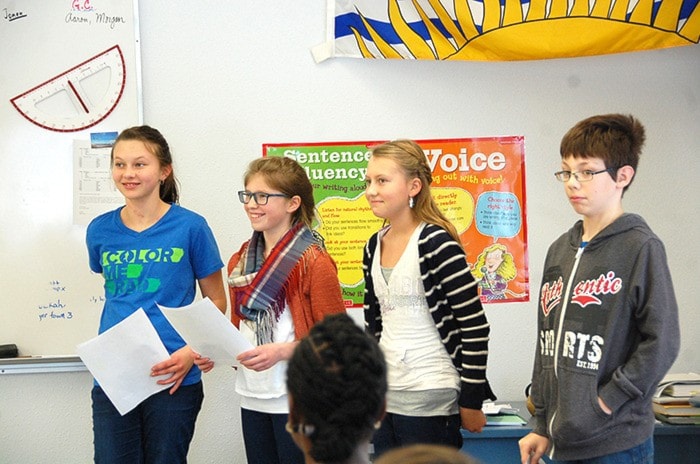A presentation about Jamie Baxter Park was performed on Dec. 1 at the Houston Christian School by the Grade 5 & 6 students in front of mayor Shane Brienen, District of Houston staff, teachers, parents and fellow students.
Four groups were created to cover four different aspects about Jamie Baxter park. Its history in relation to First Nations and the reason for its name, the various vegetation and their properties that grow in the park, the animals that inhabit and visit the area, and a list of improvement ideas proposed by the class.
The 17 students visited Jamie Baxter Park frequently to conduct their research.
When asked what the students found most interesting or surprising about what they found, many students replied howbadly the campsite needs to be cleaned up and taken care of.
“One of the things we learnt through this was a deeper respect for God’s creation. Especially in Jamie Baxter Park, when we were there, and there was a whole bunch of garbage, these kids were appalled. And so one of the biggest things that kept coming through in our study was the question, how can we clean this park up?” said John Siebenga, principal at the HoustonChristian School.
Suggestions like a graffiti wall, having the lock taken off of the gate for people to enter and have access to the campsite,new water taps for the campground, new garbage cans to help promote keeping the area clean and safe, fixing the benches and picnic tables, having firewood available for people to use, having a donation box to support the park and camp ground,swings for the playground, a small playground for the campsite, a patio between the seniors’ centre and the clinic with picnic tables and umbrellas to encourage interaction between the seniors and youth, and having a parade around JamieBaxter Park on Aboriginal Day as well as other multicultural days since the area was an importance place to the First Nation people.
Mayor Shane Brienen said he was very pleased to see the extensive research done which incorporated a lot about the FirstNation history, and to see suggestions that integrated honouring them and Jamie Baxter Park.
Don Hounsell, Manager of Engineering and Operations at the District of Houston was happy to see so many suggestions that reflected some of the work that the district is already underway to put in place such as new picnic tables, garbage cans,a concrete toilet, and adding clean water.
The students at the Houston Christian School feel that it is important to educate the community about the history of JamieBaxter Park, its impact on the First Nation people’s migration, and why it is important to take care of the area.
Their study about Jamie Baxter Park has led them down a path of fondness for the area, and created a sense of responsibility for its wellbeing to be shared with the community.
This is what the Grade 5 & 6 students discovered:
The First Nation people made trails in Houston to access hunting areas. Jamie Baxter Park was a good spot to camp because of the access to the river. The First Nations fished in the summer and hunted caribou in the fall. When Jamie Baxter Park flooded, the First Nation people moved up the land because it was so big.
Jamie Baxter Park was named after a boy who got lost along Buck Flats Road in Houston and perished because of hypothermia. Two five-year-old boys, Jamie Baxter and David Crocker, were playing outside and had wandered off. They spent a number of days and nights in the woods.
The boys got separated from each other, and David snuggled up to his dog to keep warm.
Jamie on the other hand was dressed only in a snoopy shirt, blue jeans, and summer socks and was not ready for the cold nights.
A search party was organized and David was found alive on Oct. 14 with his dog, and Jamie was found the next day but could not be revived. A trust fund for Jamie was formed and from that the park that is now Jamie Baxter Park was developed.
There used to be no moose in the area, so instead the First Nations would hunt deer, bear, rabbits, beavers, and many other animals which they used their hides to make clothes, bones for weapons, and meat for food.
Jamie Baxter Park is made up of a whole variety of plants that are necessary for its beauty, greenery, and for food to a multitude of animals that grace this lovely park. Sadly it also has some noxious weeds, like thistle.
